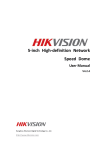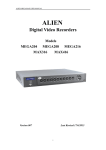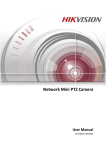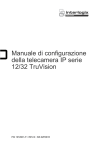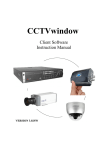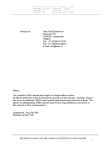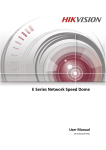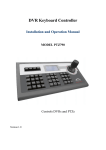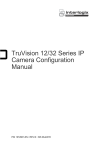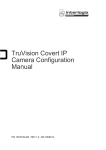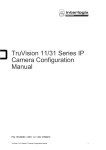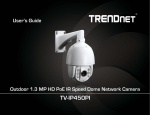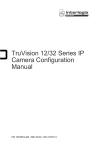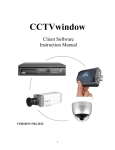Download Instructions
Transcript
User Manual for IP-PTZ643/645 IP – High Speed PTZ with IRs Models IP-PTZ643W 1.3mp IP-PTZ645W 2.0mp 20 x Optical Zoom 1.3 and 2 Megapixel models ONVIF Protocol 4.7mm ~ 94mm Lens 12 x High Power IRs up to 150m Version 007 Last Revised 02/10/2015 2 User Manual for IP-PTZ643/645 Table of Contents Chapter 1 Introduction ......................................................................................... 5 1.1 System Requirement ……………………………………………………………………………… 5 1.2 Features ……………………………………………………………………………………………5 1.3 PTZ Control ………………………………………………………………………………………. 5 1.4 Applications ………………………………………………………………………………………. 5 1.5 Product Overview ………………………………………………………………………………… 6 1.6 Installation Instructions …………………………………………………………………………....6 1.7 Power Supply and Network Connections ………………………………………………………….9 1.7.1 Power Supply Connection ………………………………………………………………..9 1.7.2 Network Cable Connection ………………………………………………………………9 1.7.3 RS485 Cable Connection ……………………………………………………………….. 9 1.7.4 Simple Troubleshooting ………………………………………………………………. ..10 1.8 Basic Operation …………………………………………………………………………………..11 1.8.1 General …………………………………………………………………………………..11 1.8.2 Power On Self Test ……………………………………………………………………....11 1.8.3 Presets ……………………………………………………………………………….......11 1.8.4 Tours/Patrols …………………………………………………………………………….11 1.9 Info on General & Function Commands ………………………………………………………….12 1.9.1 General Commands ………………………………………………………………………12 1.9.2 Function Commands ……………………………………………..……………….……...12 1.9.3 Patrol/Tour Setup Procedure ……………………………………………………………..15 1.10 Connecting IP Camera to IP DVR ……………………………………………………………….16 1.10.1 Connecting through Alien MEGA DVR …………………………………………………16 Chapter 2 Network Connection ……………………………………………….... 18 2.1 Setting the Network Zoom Camera over the LAN ………………………………………………..18 2.1.1 Wiring over the LAN …………………………………………………………………....18 2.1.2 Detecting and Changing the IP Address ………………………………………………....19 2.2 Setting the Network Camera over the WAN ………………………………………………………20 2.2.1 Static IP Connection …………………………………………………………………......20 2.2.2 Dynamic IP Connection ………………………………………………………………….21 Chapter 3 3.1 Network IP Camera ………………………………………………........ 22 Accessing by Web Browser ……………………………………………………………………….22 Chapter 4 Live View ….…………………………………………………......... 25 4.1 Live View Page ……………………………………………………………………………………25 4.2 Starting Live View ………………………………………………………………………………...26 4.3 Recording and Capturing Pictures Manually ……………………………………………………...27 4.4 Operating PTZ Control ……………………………………………………………………………27 4.4.1 PTZ Control Panel ……………………………………………………………………….27 4.4.2 Setting/Calling a Preset …………………………………………………………………..28 User Manual for IP-PTZ643/645 3 4.4.3 Setting/Calling a Patrol/Tour ………………………………………………………….…29 4.4.4 Configuring Power Off Memory ………………………………………………………...30 4.4.5 Configuring Park Actions ……………………………………………………………….30 4.5 Configuring Live View Parameters ……………………………………………………………….31 Chapter 5 Camera Configuration ……………………………………………......... 32 5.1 Configuring Local Parameters …………………………………………………………………….32 5.2 Configuring Time Settings ……………………………………………………………………… ..33 5.3 Configuring Network Settings …………………………………………………………………….36 5.3.1 Configuring TCP/IP Settings ………………………………………………………….....36 5.3.2 Configuring Port Setting ………………………………………………………………....37 5.3.3 Configuring PPPoE Settings ……………………………………………………………..38 5.3.4 Configuring DDNS Settings ……………………………………………………………..38 5.3.5 Configuring SNMP Settings ……………………………………………………………..41 5.3.6 Configuring 802.1X Settings …………………………………………………………….42 5.3.7 Configuring Quality of Service Settings ……………………………………………….43 5.3.8 Configuring FTP Settings ………………………………………………………………..44 5.3.9 Configuring UPnP Settings ………………………………………………………………45 5.3.10 Configuring NAT (Network Address Translation) Settings ………………………………46 5.3.11 Configuring Email Settings ……………………………………………………………....46 5.4 Configuring Video and Audio Settings ……………………………………………………………48 5.4.1 Configuring Video Settings ……………………………………………………………...48 5.4.2 Configuring Audio Settings ……………………………………………………………...49 5.4.3 Configuring Region of Interest (ROI) …………………………………………………...50 5.5 Configuring Display Settings ……………………………………………………………..……….51 5.5.1 Image Adjustment ………………………………………………………………………..52 5.5.2 Exposure Settings ………………………………………………………………………..52 5.5.3 Focus Settings ……………………………………………………………………………53 5.5.4 Day/Night Switch Mode ………………………………………………………………... 54 5.5.5 Backlight Settings ………………………………………………………………………..54 5.5.6 WDR (Wide Dynamic Range) …………………………………………………………...55 5.5.7 White Balance ……………………………………………………………………………55 5.5.8 Image Enhancement ……………………………………………………………………...56 5.5.9 Video Adjustment ………………………………………………………………………..56 5.5.10 Other ……………………………………………………………………………………57 5.6 Configuring OSD Settings …………………………………………………………………...……57 5.7 Configuring Text Overlay Settings ………………………………………………………………..58 5.8 Configuring Privacy Mask ………………………………………………………………………...59 5.9 Configuring and Handling Alarms ……………………………………………………………….. 60 5.9.1 Configuring Motion Detection …………………………………………………………..60 5.10 Configuring Video Tampering Alarm …………………………………………………………….. 64 5.11 Configuring External Alarm Input …………………………………………………………………65 5.11.1 Configuring Alarm Output ………………………………………………………………..67 5.12 Handling Exception ………………………………………………………………………………...68 User Manual for IP-PTZ643/645 Chapter 6 4 Record Settings …………………………………………………….....69 6.1 Configuring NAS Settings ……………………………………………………………………. 69 6.2 Configuring Record Schedule …………………………………………………………………70 6.3 Configuring Snapshot Settings ………………………………………………………………...74 Chapter 7 Playback/Download……………….. …………………………………77 7.1 Playing back video files ………………………………………………………………………..77 7.2 Downloading video files ……………………………………………………………………….79 7.3 Downloading Captured Images ………………………………………………………………...80 Chapter 8 Chapter 9 Log Searching ………………………………………………………....81 Others ………………………………………………………………….82 9.1 Managing User Accounts ……………………………………………………………………….82 9.2 Configuring RTSP Authentication ………………………………………………………………85 9.3 Configuring Anonymous Visit …………………………………………………………………..85 9.4 Configuring IP Address Filter …………………………………………………………………...86 9.5 Viewing Device Information …………………………………………………………………….86 9.6 Maintenance ……………………………………………………………………………………...87 9.6.1 Rebooting the Zoom Camera …………………………………………………………...87 9.6.2 Restoring Default Settings ………………………………………………………………87 9.6.3 Importing/Exporting Configuration File ………………………………………………...88 9.6.4 Upgrading the System …………………………………………………………………...88 9.6.5 Enabling/Disabling Telnet ……………………………………………………………… 89 9.7 RS232 Settings ……………………………………………………………………………………89 9.8 RS485 Settings ……………………………………………………………………………………90 Appendix 1 SADP Software …………………………………………………………………………….91 Appendix 2 Port Mapping ……………………………………………………………………………….92 Appendix 3 CCTVWindow ……………………………………………………………………………...95 CAUTION Make sure the power supply voltage is correct before using the camera. Do not drop the camera or subject it to physical shock. Do not touch sensor modules with fingers. If cleaning is necessary, use a clean cloth moistened with ethanol and wipe it gently. If the camera is not be used for an extended period of time, put on the lens cap on, to protect the sensor from dirt. Do not aim the camera lens at the strong light such as sun or incandescent lamp. Strong light can cause damage to the camera. The sensor may be burned out by a laser beam so avoid exposure. Do not place the camera in extremely hot or cold temperatures, avoid dusty conditions, and do not expose camera to high electromagnetic radiation. To avoid heat accumulation, good ventilation is required for a proper operating environment. During transport it is recommended that the camera is packed in its original packing. User Manual for IP-PTZ643/645 5 Chapter 1 Introduction 1.1 System Requirement System requirement of web browser accessing is as follows: Operating System: Microsoft Windows XP SP1 and above version / Vista / Win7 / Server 2003 / Server 2008 32bits CPU: Intel Pentium IV 3.0 GHz or higher RAM: 1G or higher Display: 1024×768 resolution or higher Web Browser: Internet Explorer 7.0 and above version. 1.2 Features HD Video Output Supports ONVIF protocol and JPEG picture capture Provides motion detection function Auto-focus function Advanced video compression with high compression ratio Supports dual-stream Supports JPEG picture capture Provides RS-485 and RS-232 interfaces. 1.3 PTZ Control Pans 360 degrees continuous rotation Tilts 90 degrees without any blindspot PTZ auto adjusts speed according to the zoom function Auto switches on IR lamps and adjusts IR brightness according to the lens near and far settings 1.4 Applications This IP PTZ camera can be operated using its own browser access software, CCTVWindow and NVR/ IP DVR with ONVIF protocol. 6 User Manual for IP-PTZ643/645 1.5 Product Overview Power Supply 12vDC 4A ± 10% Power Consumption Max 15w day Max 30x night IR Distance 100m ~ 120m Decoder Built In Pan Range 360° Tilt Rotate 90° High Speed Pan 0. 6° ~ 200°/s Presets 128 Monitoring Method Preset/Patrol/Auto-Scan Protection Rating IP66 Installation Wall Mount only Tilt 0.8° ~ 75°/s Standard Speed Pan 0. 6° ~ 30°/s Tilt 0.4° ~ 17°/s Operational Environment Outdoor: -20° ~ +60° Humidity 0 ~ 95% 1.6 1.6.1 Indoor: -10° ~ +50° Installation Instructions Overall Dimensions User Manual for IP-PTZ643/645 7 1.6.2 Wall Bracket Dimensions Step 1. Place bracket against wall and mark the four positions for screw holes. Step 2. Drill and plug holes. . Step 3. Feed multi-core cable from camera through bracket. User Manual for IP-PTZ643/645 Step 4. 8 Secure the camera with 4 screws to the bracket. silicon Step 5. Feed the camera cable either through the wall or take it out sideways via the access on the side of the bracket as shown above. Fix bracket to wall and seal with silicon around exposed cable entry points. Do not allow cable to run down into the camera but if cable has to run down, take cable run down below entry point and loop it upwards into entry point. Step 6. Remove transparent film from dome cover. 9 User Manual for IP-PTZ643/645 1.7 Power Supply and Network Connections RS485 Connection 1.7.1 Power Supply Connection The PTZ is rated at 12vDC using a 4Amp regulated power supply. The connector is a 2.1mm power jack. 1.7.2 Network Cable Connection The network connection is the RG45 connector. This allows connection direct to another device using a crossover cable, connecting to a router using a LAN cable or a switch. Note that the network cable should not me more than 100 metres. Each IP camera must use a unique IP address. 1.7.3 RS485 Cable Connection The RS485 cable allows the IP camera to control telemetry from a keyboard or DVR rather than via a network connection. Ensure that the + connects to the T+ connection at the back of the DVR or keypad and – to the T- connection at the back of the DVR or keypad. 10 User Manual for IP-PTZ643/645 1.7.4 Simple Troubleshooting Fault Check Possible Cause Solution No picture and no telemetry Mains power supply Motor fault Image okay but camera is not doing a self test Camera movement Power supply Replace PTZ mainboard Replace Mechanical fault Obstruction or part failure Camera angle Adjust as too sharp necessary Insufficient Use/replace power power supply Mainboard fault Replace Self tests okay but no images Power going to camera and to camera module Network cable Self test and image okay but no telemetry Client or web configuration issue Image is not sharp/colours are pale Check dome plastic cover Check PTZ focus settings Disconnection Reconnect Disconnected Cable too long IP address error Incorrect cable Check PTZ address, protocol and baud rate settings Reconnect Over 100m Change IP addr Use correct type PTZ address, protocol and baud rate must agree with PTZ camera settings Is transparent protective cover still on dome cover Remove Is dome cover dirty Clean dome cover Is camera in manual focus Set to auto focus User Manual for IP-PTZ643/645 1.8 11 Basic Operation 1.8.1 General The versatility of this IP PTZ camera allows it to communicate through different platforms. As these platforms are not the same, you will need to use reference manuals referring to the particular platform used in addition to this manual. 1.8.2 Power On Self Test When this camera is powered up, it runs a self-test by panning and tilting to prove that it works okay. This helps to diagnose problems when telemetry does not operate camera. 1.8.3 Presets A preset allows a position to be saved in the PTZ camera that can be called or used in a tour/patrol. Presets first need to be created by sending the camera a preset command linked to a number. Then by using a call/shot command the camera will then move to the preset position. Dependent on whether the keyboard, DVR or software uses an embedded Enter command will dictate the format of the preset and call command used. For example a keyboard with an Enter key could set a preset using PRESET <nn> ENTER (where nn = preset number). Where the keyboard has no Enter key, the enter is embedded in the command such as <nn> PRESET (where nn = preset number). Likewise when calling the preset a keyboard with an Enter key could send a call using CALL/SHOT <nn> ENTER (where nn = preset number) or <nn> SHOT (where nn = preset number). 1.8.4 Tours/Patrols Tours or Patrols allow you to initiate a sequence of presets automatically. This camera has no PTZ menu so every command is either a mixture of preset or call sequences. In order to cover the variety of options for controlling the PTZ camera it is necessary to use a double layer of control commands by using General Commands and Function Commands. 12 User Manual for IP-PTZ643/645 1.9 Info on General & Function Commands 1.9.1 General Commands Using double layer preset commands allows a greater option of commands to be used. The following is a list of General Commands. Like the 92 command for setting the Patrol/Tour there are other commands for Pattern setup and running, IR, etc. General Command Function Preset No. Additional Info Infra Red Functions 90 Auto/Force/Sensitivity Camera Module Functions 91 IR Cut Filter/Modules Patrol/Tour Functions 92 Patrol/Tour setup/running Pattern Functions 93 Pattern setup/running PTZ Control Functions 94 Park options/auto scan Menu 95 No menu on this PTZ System Settings 96 Factory Reset High Speed Auto Scan 98 Low Speed Auto Scan 99 1.9.2 Function Commands Function Commands are the second layer associated with a General Command. These are generally call commands that follow the General command. CALL/SHOT 90 I R FUNCTION 1 IR Auto On/Off 2 IR Forced On 3 IR Forced Off 11 IR High 12 IR Medium 13 IR Low CALL/SHOT 90, CALL/SHOT <n> Eg. CALL 90, CALL 2 (option 2) 13 User Manual for IP-PTZ643/645 CALL/SHOT 91 CAMERA MODULE FUNCTION 1 IRCUT On 2 IRCUT Off 3 IRCUT Auto On 4 IRCUT Auto Off CALL/SHOT 91, CALL/SHOT <n> Eg. CALL 91, CALL 3 (option 3) PRESET 92 PATROL/TOUR FUNCTION 1 CALL Patrol 1 2 CALL Patrol 2 3 CALL Patrol 3 4 CALL Patrol 4 5 CALL Patrol 5 6 CALL Patrol 6 7 CALL Patrol 7 8 CALL Patrol 8 9 Patrol End 10 Patrol Time 5 ~ 240s 11 Patrol Speed 1 ~ 63 Example: Create Patrol/Tour Number 1 PRESET 92, CALL/SHOT 1 Opens Patrol/Tour 1 CALL/SHOT PRESET 1, 2, 3 Etc. Add presets, then when finished CALL/SHOT 92, CALL/SHOT PRESET 9 to Save Patrol/Tour CALL/SHOT 92, CALL/SHOT 1 Runs the Patrol/Tour 1 PRESET 93 PATTERN 1 PATTERN 1 2 PATTERN 2 4 PATTERN 4 5 PATTERN END 3 PATTERN 3 Example: Create Pattern Number 1 PRESET 93, CALL/SHOT 1 Opens Pattern 1 Move PTZ to record Pattern 1 CALL/SHOT 93, CALL/SHOT PRESET 5 To Save Pattern CALL/SHOT 93, CALL/SHOT 1 Runs Pattern 1 14 User Manual for IP-PTZ643/645 CALL/SHOT 94 PTZ CONTROL 1-8 Park Preset 1-8 9-16 Park Patrol 1-8 17-20 Park Pattern 1-4 21 Park Auto Scan 22 Park AB Line 30 Park Time 0 Off 31 Park Time 10s 32 Park Time 30s 33 Park Time 60s 41 A Line scan setting 42 B Line scan setting 43 High Speed line scan start 44 Middle Speed line scan start 45 Low Speed line scan start 46 Inner Arc line scan 47 Outer Arc line scan Initiate Park to allow PTZ to return to a Preset/Tour/Pattern after time period Examples: CALL/SHOT 94, CALL 1, CALL 94, CALL 31 After 10 secs of inactivity move to Preset 1 CALL/SHOT 94, CALL 9, CALL 94, CALL 32 After 30 secs of inactivity move to Patrol/Tour 1 CALL/SHOT 94, CALL 17, CALL 94, CALL 33 After 60 secs of inactivity move to Pattern 1 CALL/SHOT94, CALL 9, CALL 94, CALL 30 Clear Park Time setting for Patrol/Tour 1 PRESET 96 10, 12, 14 RESTORE FACTORY SETTINGS Enter Calls sequentially to default settings Special Note: You will default the network settings using this restore option. PRESET 96, CALL 10, CALL 12, CALL14 User Manual for IP-PTZ643/645 15 1.9.3 Patrol/Tour Setup Procedure After setting the required presets (Refer 1.8.3) you need to create a Patrol/Tour number, add the required presets to that number, then save the settings. Note that commands for setting presets are different from commands calling presets. When setting presets press the PRESET button and when calling the preset press the CALL or SHOT button. 1.9.3.1 Create a Patrol/Tour Step 1 Create blank Patrol/Tour (n) (n = Patrol/Tour No.) Set Preset 92, Call Preset 1, to create blank Patrol/Tour No. (n) Step 2 Add presets to Patrol/Tour (n) (n = Patrol/Tour No.) Call Preset 1, to add preset 1 to Patrol/Tour No. (n) Call Preset 2, to add preset 2 to Patrol/Tour No. (n) Call Preset 3, to add preset 3 to Patrol/Tour No. (n) Call Preset 4, to add preset 4 to Patrol/Tour No. (n) Call Preset 5, to add preset 5 to Patrol/Tour No. (n) Step 3 Save Patrol/Tour No. (n) with presets Call Preset 92, Call Preset 9, to save Patrol/Tour No. (n) with presets. 1.9.3.2 Run Patrol/Tour (n) Procedure Call Preset 92, Call Preset (n) to run Patrol/Tour No. (n) 1.9.3.3 Dwell Time at preset point This option allows the changing of the time spent at each preset point before moving to the next preset point. Set Preset 92, Call Preset 10 to accept dwell time Call Preset < 5 ~ 240 > to change dwell time between 5 and 240 seconds. 1.9.3.4 Speed moving between preset points in a Patrol/Tour This option allows changing the speed between preset points Set Preset 92, Call Preset 11 to accept running speed in a Patrol/Tour Call Preset < 1 ~ 63 > to change Patrol/Tour speed between 1 and 63. 16 User Manual for IP-PTZ643/645 1.10 Connecting IP Camera to IP DVR 1.10.1 Connecting through Alien MEGA DVR Connect the camera to a router or switch and the DVR to a network using a standard LAN cable. Enter the DVR menu and select VIDEO. Click on IP Camera menu. Now click on Custom Adding 17 User Manual for IP-PTZ643/645 Complete the following:IP Camera Address as set in the PTZ camera Protocol : ONVIF Management Port: 80 User Name: admin (Username set in PTZ camera default is admin) Admin Password: 12345 (Password set in PTZ camera default is 12345) Then click Add button. Then click Back. Check that the status shows Click the arrow key to display the IP camera channel. SPECIAL NOTE: IP cameras are added to the end of the analogue channels but if an analogue is removed, it will take the lowest spare channel number available. 18 User Manual for IP-PTZ643/645 Chapter 2 Network Connection 2.1 Setting the Network Zoom Camera over the LAN Purpose: To view and configure the zoom camera via a LAN, you need to connect the network zoom camera in the same subnet as your computer, and install the SADP or CCTVWindow software to search and change the IP of the network zoom camera. 2.1.1 Wiring over the LAN The following figures show the two ways of cable connection of a network zoom camera and a computer: Purpose: To test the network zoom camera, you can directly connect the network zoom camera to the computer with a crossover cable as shown in Figure 2-1. Refer to the Figure 2-2 to set the network zoom camera over the LAN via a switch or a router. Figure 2-1 Connecting via crossover cable Figure 2-2 Connecting via a Switch or a Router 19 User Manual for IP-PTZ643/645 2.1.2 Detecting and Changing the IP Address You need the IP address to access the network zoom camera. Steps: 1. To get the IP address, you can choose either of the following methods: Use SADP, a software tool which can automatically detect the online network zoom cameras in the LAN and list the device information including IP address, subnet mask, port number, device serial number, device version, etc., shown in Figure 2-3. Use the client software to list the online devices. 2. Change the IP address, subnet mask and gateway ensuring that the same subnet and gateway used by the router are set but a unique IP is set. 3. Enter the IP address of network zoom camera in the address field of the web browser to view the live video. Notes: The default IP address is 192.0.0.64. The default user name is admin and password is 12345. For accessing the network zoom camera from different subnets, please set the gateway for the network zoom camera after you logged in. For detailed information, please refer to Section 6.3.1 Configuring TCP/IP Settings. Figure 2-3 SADP Interface User Manual for IP-PTZ643/645 20 2.2 Setting the Network Camera over the WAN Purpose: This section explains how to connect the IP camera to the WAN with a static IP or a dynamic IP. 2.2.1 Static IP Connection Before you start: Please apply a static IP from an ISP (Internet Service Provider). With the static IP address, you can connect the IP camera via a router or connect it to the WAN directly. Connecting the IP camera via a router Steps: 1. Connect the IP camera to the router. 2. Assign a LAN IP address, the subnet mask and the gateway. Refer to Section 3.1.2 Detecting and Changing the IP Address for detailed IP address configuration of the IP camera. 3. Save the static IP in the router. 4. Set port mapping, E.g., 80, 8000 and 554 ports. The steps for port mapping vary depending on different routers. Please call the router manufacturer for assistance with port mapping. 5. Connect to the IP camera through a web browser or the client software over the internet. Figure 2-4 Accessing the Zoom camera through Router with Static IP User Manual for IP-PTZ643/645 21 2.2.2 Dynamic IP Connection Before you start: Please apply a dynamic IP from an ISP. With the dynamic IP address, you can connect the IP camera to a modem or a router. Connecting the IP camera via a router Steps: 1. Connect the IP camera to the router. 2. In the IP camera, assign a LAN IP address, the subnet mask and the gateway. 3. Set port mapping. E.g. 80, 8000 and 554 ports in the router and forward to the local address set in the IP camera. The steps for port mapping vary depending on different routers. 4. Create the dynamic name e.g www.dyndns.org using a domain name provider. 5. In the client software, set the dynamic name (normal domain), port 8000*, user name and password. * port 8000 is the default server port but can be changed. 6. Configure the DDNS settings in the client software interface.. 7. Connect to the IP camera via the applied domain name through the client or browser. User Manual for IP-PTZ643/645 Chapter 3 Network IP Camera 3.1 Accessing by Web Browser Steps: 1. Open the web browser. 2. In the address field, input the IP address of the network zoom camera, e.g., 192.0.0.64 and press the Enter key to enter the login interface. 3. Input the user name and password and click . Note: The default user name is admin, password is 12345. Figure 3-1 Login Interface 4. Install the plug-in before viewing the live video and operating the zoom camera. Please follow the installation prompts to install the plug-in. 23 User Manual for IP-PTZ643/645 Figure 3-2 Download and Install Plug-in Figure 3-3 Install Plug-in (1) Figure 3-4 Install Plug-in (2) 24 User Manual for IP-PTZ643/645 Figure 3-5 Install Plug-in (3) Note: You may find when using Internet Explorer that the plug-in does not run. If this occurs you may have to enter the Tools menu in I.E (press the ALT key if the menu bar in not displayed) and select Compatibility View Settings, then add the IP address that you are accessing the IP camera on, followed by Close, close I.E then refire and the plug-in should then run correctly. This is a Windows security issue. 25 User Manual for IP-PTZ643/645 Chapter 4 4.1 Live View Live View Page Purpose: The live video page allows you to view live video, capture images, use PTZ control, set/call presets and configure video parameters. Log into the network zoom camera to enter the live view page, or you can click on the menu bar of the main page to enter the live view page. Descriptions of the live view page Click to show or hide Menu Bar PTZ control panel LiveView Parameters PTZ control Live view window Preset Toolbar Figure 4-1 Live View Page Menu Bar: Click each tab to enter Live View, Playback, Log and Configuration page respectively. Live View Window: Display the live video. Toolbar: Operations on the live view page, e.g., live view, capture, record, audio on/off, two-way audio, etc. PTZ Control: Panning, tilting, focusing and zooming actions of the camera. Preset: Set and call the preset/patrol for the camera. 26 User Manual for IP-PTZ643/645 Live View Parameters: Configure the image size and stream type of the live video. 4.2 Starting Live View In the live view window as shown in Figure 4-2, click on the toolbar to start the live view of the zoom camera. Figure 4-2 Start Live View Table 4-1 Descriptions of the Toolbar Icon Description Icon Description Live view on Live view off Manual recording off Manual recording on Audio on and adjust volume Mute Two-way audio off Two-way audio on Manually capture the pictures 3D zoom Note: Before using the two-way audio or recording with audio functions, please set the Stream Type to Video & Audio referring to Section 5.4 Configuring Video and Audio Settings. Full-screen Mode You can double-click on the live video to switch the current live view into full-screen or return to normal mode from the full-screen. 27 User Manual for IP-PTZ643/645 Please refer to the following sections for more information: Configuring remote recording in Section 6.2 Configuring Recording Schedule. Setting the image quality of the live video in Section 5.1 Configuring Local Parameters and Section 5.4.1 Configuring Video Settings. Setting the OSD text on live video in Section 5.6 Configuring OSD Settings. 4.3 Recording and Capturing Pictures Manually In the live view interface, click click on the toolbar to capture the live pictures or to record the live video. The local saving paths of the captured pictures and clips can be set in the Configuration > Local Configuration interface. To configure remote automatic recording, please refer to Section 6.2 Configuring Record Schedule. Note: The captured image will be saved as a JPEG file in your computer. 4.4 Operating PTZ Control Purpose: In the live view interface, you can use the PTZ control buttons to control panning, tilting and zooming. 4.4.1 PTZ Control Panel On the live view page, click to show the PTZ control panel or click hide it. Click the direction buttons to control the pan/tilt movements. Click the zoom/focus buttons for lens control. Figure 4-3 PTZ Control Panel to 28 User Manual for IP-PTZ643/645 Table 4-2 Description of PTZ Control Panel Button Description Zoom in/out Focus near/far Adjust speed of pan/tilt movements 4.4.2 Setting/Calling a Preset Purpose: A preset is a predefined image position. For the defined preset, you can click the call button to quickly view the desired image position. Setting a Preset: Steps: 1. In the PTZ control panel, select a preset number from the preset list. Figure 4-4 Setting a Preset 2. Use the PTZ control buttons to move the lens to the desired position. • Pan the zoom camera to the right or left. • Tilt the zoom camera up or down. • Zoom in or out. • Refocus the lens. 3. Click to finish the setting of the current preset. 4. You can click to delete the preset. Note: You can configure up to 255 presets. Calling a Preset: In the PTZ control panel, select a defined preset from the list and click preset. to call the 29 User Manual for IP-PTZ643/645 Figure 4-5 Calling a Preset 4.4.3 Setting / Calling a Patrol/Tour Purpose: A patrol/tour is a series of presets. It can be configured and called on the patrol settings interface. There are up to 8 patrols for customising. A patrol can be configured with up to 32 presets. Before you start: Please make sure that the presets you want to add into a patrol have been defined. Setting a Patrol: Steps: 1. In the PTZ control panel, click 2. Select a patrol number from 3. Click to enter the patrol settings interface. . to enter the adding interface for preset as shown in Figure 4-6. Figure 4-6 Adding Presets User Manual for IP-PTZ643/645 30 4. Configure the preset number, patrol time and patrol speed. Name Description Patrol Time It is the time staying on one preset point. The camera moves to another preset point after the time set. Patrol Speed It is the speed of moving from one preset to another. 5. Click to save a preset into the patrol. 6. Repeat the steps from 3 to 5 to add more presets. 7. Click to save all the patrol/tour settings. 4.4.4 Configuring Power Off Memory Purpose: The PTZ camera can resume its previous PTZ status or actions after it restarted from a power-off. You can set the time prior to the camera resuming its PTZ function. 1. Enter the Basic PTZ Parameter Configuration interface: Configuration > Advanced Configuration > PTZ > Basic Figure 4-7 Basic PTZ Configuration Interface 2. Set the resume time to 30 seconds, 60 seconds, 300 seconds or 600 seconds before power-off. 3. Click to save the settings. 4.4.5 Configuring Park Actions Purpose: This feature allows the zoom camera to start a predefined park action (scan, preset, patrol, etc.) automatically after a period of inactivity (park time). Steps: 1. Enter the Park Action Settings interface: Configuration > Advanced Configuration> PTZ > Park Action 31 User Manual for IP-PTZ643/645 Figure 4-8 Set the Park Action 2. 3. Check the checkbox to Enable Park Action. Set the Park Time as the inactivity time of the zoom camera before it starts the park actions. 4. Choose Action Type the from the drop-down list. Auto scan, patrol and preset are available. 5. Click to save the settings. 4.5 Configuring Live View Parameters Mainstream/Sub-stream: You can select or as the stream type of live viewing. The main stream is with a relatively high resolution and needs greater bandwidth. The sub-stream is low resolution and so needs less bandwidth. The default setting of stream type is . Note: Please refer to Section 5.4.1 Configuring Video Settings for more detailed parameter settings of the main stream and sub-stream respectively. Image Size: You can scale up/down the live view image by clicking image size can be 4:3, 16:9, original or auto. . the User Manual for IP-PTZ643/645 Chapter 5 5.1 Camera Configuration Configuring Local Parameters Note: The local configuration refers to the parameters in the live view and other operations using the web browser. Steps: 1. Enter the Local Configuration interface: Configuration > Local Configuration Figure 5-1 Local Configuration Interface 2. Configure the following settings: Live View Parameters: Set the protocol type, stream type, image size and live view performance. Protocol Type: TCP, UDP, MULTICAST and HTTP are selectable. TCP: Ensures complete delivery of streaming data and better video quality, yet the real-time transmission will be affected. UDP: Provides real-time audio and video streams. HTTP: Allows the same quality as of TCP without setting specific ports for streaming under some network environments. MULTICAST: It’s recommended to select the protocol type to when using the Multicast function. 33 User Manual for IP-PTZ643/645 Live View Performance: Set the live view performance to Least Delay, Balanced or Best Fluency. Record File Settings: Set the saving path of the video files. Record File Size: Select the packed size of manually recorded and downloaded video files. The size can be set to 256M, 512M or 1G. Save record files to: Set the saving path for the manually recorded video files. Save downloaded files to: Set the saving path for the downloaded video files in interface. Picture and Clip Settings: Set the saving paths of the captured pictures and clipped video files. Save snapshots in live view to: Set the saving path of the manually captured pictures in interface. Save snapshots when playback to: Set the saving path of the captured pictures in interface. Save clips to: Set the saving path of the clipped video files in interface. Note: You can click to change the directory for saving video files, clips and pictures. 3. Click 5.2 to save the settings. Configuring Time Settings Purpose: You can follow the instructions in this section to configure the time which can be displayed on the video. There is Time Zone, Time Synchronisation and Daylight Saving Time(DST) function for setting the time. Time Synchronisation consists of auto mode by Network Time Protocol (NTP) server and manual mode. To enter the Time Settings interface: Configuration > Basic Configuration > System > Time Settings or Configuration > Advanced Configuration > System > Time Settings 34 User Manual for IP-PTZ643/645 Figure 5-2 Time Settings Configuring Time Synchronisation by NTP Server (1) Check the checkbox to enable the NTP function. (2) Configure the following settings: Server Address: IP address of NTP server. NTP Port: Port of NTP server. Interval: The time interval between the two synchronising actions by NTP server. It can be set from 1 to 10080 minutes. Figure 5-3 Time Sync by NTP Server You can click Test to make sure that the NTP server is connected. Note: If the zoom camera is connected to a public network, you should use an NTP server that has a time synchronisation function, such as the server at the National Time Center (IP Address: 210.72.145.44). If the zoom camera is set in a customised network, NTP software can be used to establish an NTP server for time synchronisation. 35 User Manual for IP-PTZ643/645 Configuring Time Synchronisation Manually (1) Check the Manual Time Sync checkbox. (2) Click (3) Click to set the system time from the pop-up calendar. to save the settings. Note: You can also check the Sync with local time checkbox to synchronise the time of the zoom camera with the time of your computer. Figure 5-4 Time Sync Manually Select the Time Zone Purpose: When the zoom camera is taken to another time zone, you can use the Time Zone function to adjust the time. The time will be adjusted according to the original time and the time difference between the two time zones. From the Time Zone drop-down menu as shown in Figure 5-5, select the Time Zone in which the zoom camera locates. Figure 5-5 Time Zone Settings Configuring Daylight Saving Time (summer time) Purpose: The time will be adjusted automatically when the Daylight Saving Time(DST) date arrives. Steps: (1) Enter the DST interface by Configuration > Advanced Configuration > System > DST (2) Check to enable the DST function. (3) Set the date of the DST period. (4) Click to save the settings. 36 User Manual for IP-PTZ643/645 Figure 5-6 DST Settings 5.3 Configuring Network Settings 5.3.1 Configuring TCP/IP Settings Purpose: TCP/IP settings must be properly configured before you operate the zoom camera over network. Steps: 1. Enter TCP/IP Settings interface: Configuration > Basic Configuration > Network > TCP/IP Or Configuration > Advanced Configuration > Network > TCP/IP Figure 5-7 TCP/IP Settings 37 User Manual for IP-PTZ643/645 2. Configure the NIC settings, including the IPv4(IPv6) Address, IPv4(IPv6) Subnet Mask and IPv4(IPv6) Default Gateway. 3. Click Test to make sure that the IP address is not used.(optional) 4. Click to save the above settings. Notes: If the DHCP server is available, you can check to automatically obtain an IP address and other network settings from that server. The valid value range of Maximum Transmission Unit(MTU) is 100 ~ 1500. The default value is 1500. The Multicast sends a stream to the multicast group address and allows multiple clients to acquire the stream at the same time by requesting a copy from the multicast group address. Before utilising this function, you have to enable the Multicast function of your router and configure the gateway of the network zoom camera. If the DNS server settings are required for some applications (e.g., sending email), you should properly configure the Preferred DNS Server and Alternate DNS server. Note: The router must support the route advertisement function if you select Route Advertisement as the IPv6 mode. 5.3.2 Configuring Port Settings Purpose: If there is a router and you want to access the zoom camera through Wide Area Network (WAN), you need to set the 3 ports for the zoom camera. Steps: 1. Enter the Port Settings interface: Configuration > Basic Configuration > Network > Port Or Configuration > Advanced Configuration > Network > Port Figure 5-8 Port Settings 2. Set the RTSP port of the zoom camera. HTTP Port: The default port number is 80. RTSP Port: The default port number is 554. HTTPS Port: The default port number is 443. SDK Port: The default port number is 8000. 38 User Manual for IP-PTZ643/645 3. Click to save the settings. 5.3.3 Configuring PPPoE Settings Purpose: If you have no router but only a modem, you can use Point-to-Point Protocol over Ethernet (PPPoE) function. Note that this is not generally available in the UK. Steps: 1. Enter the PPPoE Settings interface: Configuration >Advanced Configuration > Network > PPPoE Figure 5-9 PPPoE Settings 2. Check the Enable PPPoE checkbox to enable this feature. 3. Enter User Name, Password, and Confirm password for PPPoE access. Note: The User Name and Password should be assigned by your ISP. 4. Click 5.3.4 to save and exit the interface. Configuring DDNS Settings Purpose: If your roter is not supported by a static IP address you can use the Dynamic DNS (DDNS) for network access. Before you start: Registration on the DDNS server is required before configuring the DDNS settings of the zoom camera. Steps: 1. Enter the DDNS Settings interface: Configuration > Advanced Configuration > Network > DDNS 39 User Manual for IP-PTZ643/645 Figure 5-10 DDNS Settings 2. Check the Enable DDNS checkbox to enable this feature. 3. Select DDNS Type. Four DDNS types are selectable: IPServer, DynDNS, HiDDNS and NO-IP. DynDNS: Steps: (1)Enter Server Address of DynDNS (e.g. members.dyndns.org). (2)In the Domain text field, enter the domain name obtained from the DynDNS website. (3)Enter the Port of DynDNS server. (4)Enter the User Name and Password registered on the DynDNS website. (5)Click to save the settings. Figure 5-11 DynDNS Settings IP Server: Steps: (1) Enter the Server Address of the IP Server. (2) Click to save the settings. Note: The Server Address should be entered with the static IP address of the computer that runs the IP Server software. For the IP Server, you have to apply a static IP, subnet mask, gateway and preferred DNS from the ISP. 40 User Manual for IP-PTZ643/645 Figure 5-12 IPServer Settings HiDDNS: Steps: (1) Enter the Server Address: www.hik-online.com. (2) Enter the Domain name of the camera. The domain is the same with the device alias in the HiDDNS server. (3) Click to save the settings. Figure 5-13 HiDDNS Settings NO-IP: Steps: (1)Enter Server Address of NO-IP. (2)In the Domain text field, enter the domain name obtained from the NO-IP website. (3)Enter the Port of NO-IP server. (4)Enter the User Name and Password registered on the NO-IP website. (5)Click to save the settings. 41 User Manual for IP-PTZ643/645 5.3.5 Configuring SNMP Settings Purpose: You can use SNMP to get zoom camera status and parameters related information. Before you start: Before setting the SNMP, please use the SNMP software and manage to receive the zoom camera information via SNMP port. By setting the Trap Address, the zoom camera can send the alarm event and exception messages to the surveillance center. Note: The SNMP version you select should be the same as that of the SNMP software. Steps: 1. Enter the SNMP Settings interface: Configuration > Advanced Configuration > Network > SNMP Figure 5-14 SNMP Settings 42 User Manual for IP-PTZ643/645 2. Check the corresponding version checkbox ( , , ) to enable the feature. 3. Configure the SNMP settings. Note: The configuration of the SNMP software should be the same as the settings you configure here. 4. Click to save and finish the settings. 5.3.6 Configuring 802.1X Settings Purpose: The zoom camera supports IEEE 802.1X standard. IEEE 802.1X is a port-based network access control. It enhances the security level of the LAN. When devices connect to this network with IEEE 802.1X standard, the authentication is needed. If the authentication fails, the devices don’t connect to the network. The protected LAN with 802.1X standard is shown as follows: Authenticator Network Dome Network Switch Net Authentication Server PC PC RADIUS Server Figure 5-15 Protected LAN Before connecting the network camera to the protected LAN, please apply a digital certificate from a Certificate Authority. The network camera requests access to the protected LAN via the authenticator 43 User Manual for IP-PTZ643/645 (a switch). The switch forwards the identity and password to the authentication server (RADIUS server). The switch forwards the certificate of authentication server to the network camera. If all the information is validated, the switch allows the network access to the protected network. Steps: 1. Connect the network camera to your PC directly with a network cable. 2. Enter the 802.1X Settings interface: Configuration > Advanced Configuration > Network > 802.1X Figure 5-16 802.1X Settings 3. 4. 5. Check the Enable IEEE 802.1X checkbox to enable it. Configure the 802.1X settings, including user name and password. Note: The EAP-MD5 version must be identical with that of the router or the switch. Enter the user name and password (issued by the CA) to access the server. 6. Click 7. Notes: The camera reboots when you save the settings. After the configuration, connect the camera to the protected network. to finish the settings. 5.3.7 Configuring QoS Settings Purpose: QoS (Quality of Service) can help solve the network delay and network congestion by configuring the priority of data sending. Steps: 1. Enter the QoS Settings interface: Configuration >Advanced Configuration > Network > QoS 44 User Manual for IP-PTZ643/645 Figure 5-17 QoS Settings 2. Configure the QoS settings, including video / audio DSCP, event / alarm DSCP and Management DSCP. The valid DSCP value ranges from 0 to 63. The DSCP value is bigger, the priority is higher. 3. Click to save the settings. Notes: Make sure that you enable the QoS function of your network device (such as a router). It will ask for a reboot for the settings to take effect. 5.3.8 Configuring FTP Settings Purpose: You can set a FTP server and configure the following parameters for uploading captured pictures. Note this service is not supported. Steps: 1. Enter the FTP Settings interface: Configuration >Advanced Configuration > Network > FTP Figure 5-18 FTP Settings 45 User Manual for IP-PTZ643/645 2. Configure the FTP settings, including server address, port, user name, password, directory and upload type. Setting the directory in FTP server for saving files: In the Directory Structure field, you can select the root directory, parent directory and child directory. Root directory: The files will be saved in the root of FTP server. Parent directory: The files will be saved in a folder in FTP server. The name of folder can be defined as shown in following Figure 5-19. Figure 5-19 Parent Directory Child directory: It is a sub-folder which can be created in the parent directory. The files will be saved in a sub-folder in FTP server. The name of folder can be defined as shown in following Figure 5-20. Figure 5-20 Child Directory Upload type: To enable uploading the captured picture to the FTP server. to save the settings. 3. Click 4. You can click Test successfully.(optional) to make sure that the FTP function is set 5.3.9 Configuring UPnP™ Settings Universal Plug and Play (UPnP™) is a networking architecture that provides compatibility among networking equipment, software and other hardware devices. The UPnP protocol allows devices to connect seamlessly and to simplify the implementation of networks in the house and corporate environments. With the function enabled, you don’t need to configure the port mapping for each port, and the camera is connected to the Wide Area Network via the router. Steps: 1. Enter the UPnP™ settings interface. Configuration >Advanced Configuration > Network > UPnP 2. Check the checkbox to enable the UPnP™ function. You can edit the Friendly Name of the camera. This name can be detected by corresponding device, such as a router. 46 User Manual for IP-PTZ643/645 Figure 5-21 Configure UPnP Settings 5.3.10 Configuring NAT (Network Address Translation) Settings Steps: 1. Set the port mapping mode: To port mapping with the default port numbers: Choose To port mapping with the customised port numbers: Choose Then you can customise the value of the port number by yourself. 2. Click to save the settings. 5.3.11 Configuring Email Settings Purpose: The system can be configured to send an Email notification to all designated receivers if an alarm event is detected, e.g., motion detection event, video loss, video tampering, etc. Before you start: Please configure the DNS Server settings under Basic Configuration > Network > TCP/IP or Advanced Configuration > Network > TCP/IP before using the Email function. Steps: 1. Enter the Email Settings interface: 47 User Manual for IP-PTZ643/645 Configuration > Advanced Configuration > Network > Email Figure 5-22 Email Settings 2. Configure the following settings: Sender: The name of the email sender. Sender’s Address: The email address of the sender. SMTP Server: The SMTP Server IP address or host name (e.g., smtp.263xmail.com). Tip: Ping the SMTP server and use the IP address instead will avoid problems with resolving the name. SMTP Port: The SMTP port. (The default TCP/IP port for SMTP is 25). Enable SSL: Check the checkbox to enable SSL if it is required by the SMTP server. Attached Image: Check the checkbox of Attached Image if you want to send 48 User Manual for IP-PTZ643/645 emails with attached alarm images. Interval: The interval refers to the time between two actions of sending attached pictures. Authentication (optional): If your email server requires authentication, check this checkbox to use authentication to log in to this server and enter the login user name and password. Receiver: Select the receiver to which the email is sent. Up to 2 receivers can be configured. Receiver: The name of the user to be notified. Receiver’s Address: The email address of user to be notified. (Optional: click Test to make sure that the email server can send email out.) 3. Click 5.4 5.4.1 to save the settings. Configuring Video and Audio Settings Configuring Video Settings Steps: 1. Enter the Video Settings interface: Configuration >Basic Configuration > Video / Audio > Video Or Configuration > Advanced Configuration > Video / Audio > Video Figure 5-23 Configure Video Settings 2. Select the Stream Type of the zoom camera to main stream (normal) or sub-stream. User Manual for IP-PTZ643/645 49 The main stream is usually for recording and live viewing with good bandwidth, and the sub-stream can be used for live viewing when the bandwidth is limited. Refer to the Section 5.1 Configuring Local Parameters for switching the main stream and sub-stream for live viewing. 3. You can customise the following parameters for the selected main stream or sub-stream: Video Type: Select the stream type to video stream, or video & audio composite stream. The audio signal will be recorded only when the Video Type is Video & Audio. Resolution: Select the resolution of the video output. Bitrate Type: Select the bitrate type to constant or variable. Video Quality: When bitrate type is selected as Variable, 6 levels of video quality are selectable. Frame Rate: The frame rate is to describe the frequency at which the video stream is updated and it is measured by frames per second (fps). A higher frame rate is advantageous when there is movement in the video stream, as it maintains image quality throughout. Max. Bitrate: Set the max. bitrate to 32~16384 Kbps. The higher value corresponds to the higher video quality, but the higher bandwidth is required. Video Encoding: The video encoding standard can be set to H.264, MPEG4 or MJPEG. Profile: You can set the profile level to High Profile, Main Profile or Basic Profile. I Frame Interval: Set the I-Frame interval from 1 to 400. SVC: SVC is a video encoding technology. It extracts frames from the original video and sends these frames to a video recorder which also supports SVC function when the network bandwidth is insufficient. Smoothing: Drag the slider to set the image as clear or smooth. 4. Click to save the settings. 5.4.2 Configuring Audio Settings Steps: 1. Enter the Audio Settings interface Configuration > Basic Configuration > Video / Audio > Audio Or Configuration > Advanced Configuration > Video / Audio > Audio 50 User Manual for IP-PTZ643/645 Figure 5-24 Audio Settings 2. Configure the following settings. Audio Encoding: G.722.1, G.711ulaw, G.711alaw, MP2L2 and G.726 selectable. Audio Input: When an intercom is connected to the camera, you need to set this option to LineIn. When a microphone is connected to the camera, you need to set this option to MicIn. Input Volume: Slid the bar to turn up/down the volume. The value ranges from 0 to 100. 3. Click to save the settings. 5.4.3 Configuring ROI Before you start: ROI (Region of Interest) encoding is used to enhance the quality of images which are specified in advance. Stream Type: You can set the ROI function for main stream, sub stream or third stream. Select a stream type and then configure the ROI settings. Fixed Region: The fixed region encoding is the ROI encoding for the manually configured area. You can choose the Image Quality Enhancing level for ROI encoding and you can also name the ROI area. Steps: 1. Select a Region No.. 2. Check the check box of Enable under Fixed Region. 3. Click 4. Adjust the ROI level from 1 to 6. The higher the value, the better image quality in the red frame. Enter a Region Name and click Save to save the settings. 5. and draw a red frame in the live view image. 51 User Manual for IP-PTZ643/645 Figure 5-25 Region of Interest 5.5 Configuring Display Settings Purpose: You can set the image quality of the network camera, including brightness, contrast, saturation, sharpness, etc. Note: The parameters in Display Settings interface vary depending on the models of network camera. Steps: 1. Enter the Display Settings interface: Configuration > Basic Configuration> Image> Display Settings or Configuration > Advanced Configuration> Image> Display Settings 2. Set the image parameters of the network camera. 52 User Manual for IP-PTZ643/645 Figure 5-26 Display Settings 5.5.1 Image Adjustment Brightness This feature is used to adjust brightness of the image. The value ranges from 0 to 100. Contrast This feature enhances the difference in color and light between parts of an image. The value ranges from 0 to 100. Saturation This feature is used to adjust color saturation of the image. The value ranges from 0 to 100. Sharpness Sharpness function enhances the detail of the image by sharpening the edges in the image. The value ranges from 0 to 100. This function varies depending on the models of zoom camera. 5.5.2 Exposure Settings Exposure Mode The Exposure Mode can be set to Auto, Iris Priority, Shutter Priority, Manual. 53 User Manual for IP-PTZ643/645 Auto: The iris, shutter and gain values will be adjusted automatically according to the brightness of the environment. Iris Priority: The value of iris needs to be adjusted manually. The shutter and gain values will be adjusted automatically according to the brightness of the environment. Figure 5-27 Manual Iris Shutter Priority: The value of shutter needs to be adjusted manually. The iris and gain values will be adjusted automatically according to the brightness of the environment. Figure 5-28 Manual Shutter Manual: In Manual mode, you can adjust the values of Gain, Shutter, Iris manually. This function varies depending on the models of zoom camera. Limit Gain This feature is used to adjust gain of the image. The value ranges from 0 to 100. Slow Shutter This function can be used in underexposure condition. It lengthens the shutter time to ensure full exposure. The slow shutter value can be set to Slow Shutter*2, *4, *6, *12, *16, *24 and *32. Figure 5-29 Slow Shutter 5.5.3 Focus Settings Focus Mode The Focus Mode can be set to Auto, Manual, Semi-auto. Auto: The camera focuses automatically at any time according to objects in the scene. Semi-auto: The camera focuses automatically only once after panning, tilting and zooming. Manual: In Manual mode, you need to use on the control panel to focus 54 User Manual for IP-PTZ643/645 manually. Min. Focus Distance This function is used to limit the minimum focus distance. The value can be set to 1.5m, 3m, 6m, 10cm and 50cm. The minimum focus value varies depending on the models of camera. 5.5.4 Day/Night Switch The Day/Night Switch mode can be set to Auto, Day and Night. Auto: In Auto mode, the day mode and night mode can switch automatically according to the light condition of environment. The switching sensitivity can be set to Low, Normal, High. Figure 5-30 Auto Mode Sensitivity Day: In Day mode, the camera displays color image. It is used for normal lighting conditions. Night: In Night mode, the image is black and white. Night mode can increase the sensitivity in low light conditions. Schedule In Schedule mode, you can set the time schedule for day mode as shown in Figure 5-31. The rest time out of the schedule is for night mode. This function varies depending on the models of zoom camera. Figure 5-31 Day Night Schedule 5.5.5 Backlight Settings BLC If there’s a bright backlight, the subject in front of the backlight appears silhouetted or dark. Enabling BLC(back light compensation) function can correct the exposure of the subject. But the backlight environment is washed out to white. 55 User Manual for IP-PTZ643/645 5.5.6 WDR (Wide Dynamic Range) The wide dynamic range (WDR) function helps the camera provide clear images even under back light circumstances. When there are both very bright and very dark areas simultaneously in the field of view, WDR balances the brightness level of the whole image and provide clear images with details. You can enable or disable the WDR function as shown in Figure 5-32. The wide dynamic level ranges from 0 to 100. Figure 5-32 WDR This function varies depending on the models of zoom camera. HLC HLC (High Light Compensation) makes the camera identify and suppress the strong light sources that usually flare across a scene. This makes it possible to see the detail of the image that would normally be hidden. 5.5.7 White Balance The White Balance mode can be set to Auto, MWB, Outdoor, Indoor, Fluorescent Lamp, Sodium Lamp and Auto-Track. Auto: In Auto mode, the camera retains colour balance automatically according to the current colour temperature. Manual White Balance: In MWB mode, you can adjust the colour temperature manually to meet your own demand as shown in Figure 5-33. Figure 5-33 Manual White Balance Outdoor You can select this mode when the zoom camera is installed in outdoor environment. Indoor You can select this mode when the zoom camera is installed in indoor environment. Fluorescent Lamp You can select this mode when there are fluorescent lamps installed near the zoom camera. Sodium Lamp You can select this mode when there are sodium lamps installed near the zoom User Manual for IP-PTZ643/645 56 camera. Auto-Track In Auto-Track mode, white balance is continuously being adjusted in real-time according to the colour temperature of the scene illumination. This function varies depending on the models of zoom camera. 5.5.8 Image Enhancement 3D Digital Noise Reduction The 3D digital noise reduce function processes the noise in the video signal. You can set Digital Noise Reduction function to Normal Mode and adjust the Noise Reduction Level as shown in Figure 5-34. The level ranges from 0 to 100. If you are a professional technician, you can set it to Expert Mode then adjust Space DNR Level and Time DNR Level. Figure 5-34 3D Digital Noise Reduction This function varies depending on the models of zoom camera. De-fog Mode When there is fog in the image, you can enable this function to get clear image. This function varies depending on the models of zoom camera. 5.5.9 Video Adjustment Mirror If you turn the MIRROR function on, the image will be flipped. It is like the image in the mirror. The flip direction can be set to OFF, LEFT/RIGHT, UP/DOWN or CENTER. This function varies depending on the models of zoom camera. Video Standard You can set the Video Standard to 50hz(PAL) or 60hz(NTSC) according to the video system in your country. This function varies depending on the models of zoom camera. 57 User Manual for IP-PTZ643/645 5.5.10 Other Lens Initialisation The lens operates the movements for initialisation when you check the check box for Lens Initialisation. Zoom Limit You can set Zoom Limit value to limit the maximum value of zooming. The value can be set to 20, 40, 80, 160 and 320. This function varies depending on the models of zoom camera. Local Output You can select the output mode to ON or OFF. 5.6 Configuring OSD Settings You can customise the on screen display of time and camera name. Steps: 1. Enter the OSD Settings interface: Configuration > Advanced Configuration > Image > OSD Settings Figure 5-35 OSD Settings 2. Check the corresponding checkbox to select the display of zoom camera name, date or week if required. 3. Edit the zoom camera name in the text field of Camera Name. 4. Select from the drop-down list to set the time format, date format, display mode and OSD size. 5. You can use the mouse to click and drag the text frame in the live view window to adjust the OSD position. 58 User Manual for IP-PTZ643/645 Figure 5-36 Adjust OSD Location 6. Click 5.7 to activate above settings. Configuring Text Overlay Settings Purpose: You can customise the text overlay. Steps: 1. Enter the Text Overlay Settings interface: Configuration > Advanced Configuration > Image > Text Overlay 2. Check the checkbox in front of textbox to enable the on-screen display. 3. Input the characters in the textbox. 4. Use the mouse to click and drag the red text frame to adjust the text overlay position. 5. Click . Note: There are up to 4 text overlays configurable. in the live view window 59 User Manual for IP-PTZ643/645 Figure 5-37 Text Overlay Settings 5.8 Configuring Privacy Mask Purpose: Privacy mask enables you to cover certain areas on the live video to prevent certain spots in the surveillance area from being live viewed and recorded. Steps: 1. Enter the Privacy Mask Settings interface: Configuration > Advanced Configuration> Image > Privacy Mask 2. Check the checkbox of Enable Privacy Mask to enable this function. 3. Click . Figure 5-38 Privacy Mask Settings 60 User Manual for IP-PTZ643/645 4. Click and drag the mouse in the live video window to draw the mask area. Note: You are allowed to draw up to 4 areas on the same image. 5. Click to finish drawing or click to clear all of the areas you set without saving them. 6. Click 5.9 to save the settings. Configuring and Handling Alarms Purpose: This section explains how to configure the network zoom camera to respond to alarm events, including motion detection, external alarm input, video tampering and exception. These events can trigger the alarm actions, such as Notify Surveillance Center, Send Email, Trigger Alarm Output, etc. For example, when an external alarm is triggered, the network zoom camera sends a notification to an e-mail address. 5.9.1 Configuring Motion Detection Purpose: Motion detection is a feature which can trigger alarm actions and actions of recording videos when the motion occurred in the surveillance scene. Steps: 1. Set the Motion Detection Area. Steps: (1) Enter the motion detection settings interface Configuration > Advanced Configuration> Events > Motion Detection (2) Check the checkbox of Enable Motion Detection. 61 User Manual for IP-PTZ643/645 Figure 5-39 Enable Motion Detection (3)Click . Click and drag the mouse on the live video image to draw a motion detection area. Note: You can draw up to 8 motion detection areas on the same image. (4)Click Note: You can click 2. to finish drawing. to clear all of the areas. (5)Move the slider detection. Set the Arming Schedule for Motion Detection. Steps: to set the sensitivity of the (1) To edit the arming schedule as shown in Figure 5-41, click Figure 5-40. in 62 User Manual for IP-PTZ643/645 Figure 5-40 Arming Schedule (2) Choose the day you want to set the arming schedule as shown in Figure 5-41. (3) Click to set the time period for the arming schedule. (4) After you set the arming schedule, you can click to copy the schedule to other days (Optional). (5) Click to save the settings. Note: The time of each period can’t be overlapped. Up to 4 periods can be configured for each day. 63 User Manual for IP-PTZ643/645 Figure 5-41 Arming Time Schedule 3. Set the Alarm Actions for Motion Detection. Purpose: You can specify the linkage method when an event occurs. The following contents are about how to configure the different types of linkage method. Figure 5-42 Linkage Method Check the checkbox to select the linkage method. Notify surveillance center, send email, upload to FTP, trigger channel and trigger alarm output are selectable. Notify Surveillance Center Send an exception or alarm signal to remote management software when an event occurs. Send Email Send an email with alarm information to a user or users when an event occurs. Note: To send the Email when an event occurs, you need to refer to Section 5.3.11 Configuring Email Settings to set the Email parameters. 64 User Manual for IP-PTZ643/645 Upload to FTP Capture the image when an alarm is triggered and upload the picture to a FTP server. Note: You need a FTP server and set FTP parameters first. Refer to Section 5.3.8 Configuring FTP Settings for setting FTP parameters. Trigger Channel Record a video when an event occurs. Note: You have to set the recording schedule to initiate this function. Please refer to Section 6.2 Configuring Record Schedule for settings the recording schedule. Trigger Alarm Output Trigger one or more external alarm outputs when an event occurs. Note: To trigger an alarm output when an event occurs, please refer to Section 5.11.1 Configuring Alarm Output to set the alarm output parameters. 5.10 Configuring Video Tampering Alarm Purpose: You can configure the zoom camera to trigger the alarm actions when the lens is covered. Steps: 1. Enter the video tampering Settings interface: Configuration > Advanced Configuration > Events > Video Tampering Figure 5-43 video tampering Alarm User Manual for IP-PTZ643/645 65 2. Check Enable video tampering checkbox to enable the video tampering detection. 3. Set the video tampering area. Refer to Step 1 Set the Motion Detection Area in Section 5.9.1 Configuring Motion Detection. 4. Click to edit the arming schedule for video tampering. The arming schedule configuration is the same as the setting of the arming schedule for motion detection. Refer to Step 2 Set the Arming Schedule for Motion Detection in Section 5.9.1 Configuring Motion Detection. 5. Check the checkbox to select the linkage method taken for the video tampering. Notify surveillance center, send email and trigger alarm output are selectable. Please refer to Step 3 Set the Alarm Actions for Motion Detection in Section 5.9.1 Configuring Motion Detection. 6. Click 5.11 to save the settings. Configuring External Alarm Input Steps: 1. Enter the Alarm Input Settings interface: Configuration > Advanced Configuration> Events > Alarm Input: 2. Choose the alarm input No. and the Alarm Type. The alarm type can be NO (Normally Open) and NC (Normally Closed). 3. Edit the name in name for the alarm input (optional). to set a 66 User Manual for IP-PTZ643/645 Figure 5-44 Alarm Input Settings 4. Click to set the arming schedule for the alarm input. Refer to Step 2 6. Set the Arming Schedule for Motion Detection in Section 5.9.1 Configuring Motion Detection. Check the checkbox to select the linkage method taken for the alarm input. Refer to Step 3 Set the Alarm Actions for Motion Detection in Section 5.9.1 Configuring Motion Detection. You can copy your settings to other alarm inputs. 7. Click 5. to save the settings. 67 User Manual for IP-PTZ643/645 Figure 5-45 Linkage Method 5.11.1 Configuring Alarm Output Steps: 1. Enter the Alarm Output Settings interface: Configuration>Advanced Configuration> Events > Alarm Output 2. Select one alarm output channel in the Alarm Output drop-down list. 3. 4. Set a name in for the alarm output (optional). The Delay time can be set to 5sec, 10sec, 30sec, 1min, 2min, 5min, 10min or Manual. The delay time refers to the time duration that the alarm output remains in effect after alarm occurs. 5. Click 6. configuration is the same as the settings of the arming schedule for motion detection. Refer to Step 2 Set the Arming Schedule for Motion Detection in Section 5.9.1 Configuring Motion Detection. You can copy the settings to other alarm outputs. 7. Click to enter the Edit Schedule Time interface. The time schedule to save the settings. 68 User Manual for IP-PTZ643/645 Figure 5-46 Alarm Output Settings 5.12 Handling Exception The exception type can be HDD full, HDD error, network disconnected, IP address conflict and illegal login to the zoom cameras. Steps: 1. Enter the Exception Settings interface: Configuration > Advanced Configuration> Events > Exception 2. Check the checkbox to set the actions taken for the Exception alarm. Refer to Step 3 Set the Alarm Actions Taken for Motion Detection in Section 5.9.1 Configuring Motion Detection. Figure 5-47 Exception Settings 3. Click to save the settings. 69 User Manual for IP-PTZ643/645 Chapter 6 Record Settings Before you start: To configure record settings, please make sure that you have the network storage device within the network or the SD card (optional) inserted in your zoom camera. 6.1 Configuring NAS Settings Before you start: The network disk should be available within the network and properly configured to store the recorded files, log files, etc. Steps: 1. Add the network disk (1) Enter the NAS (Network-Attached Storage) Settings interface: Configuration > Advanced Configuration > Storage > NAS (2) Select the NAS type as NFS or SMB/CIFS. If you select SMB/CIFS, you need to enter the User Name and Password. Figure 6-1 Select NAS Type (3) Enter the IP address of the network disk. The default NFS storage format of file path is /dvr/test as shown in Figure 6-2. And the default SMB/CIFS storage format of file path is /test. (4) Click Test to make sure that the NAS is connected successfully.(Optional) Figure 6-2 Add Network Disk The network disk file path name share is user-defined while creating the DVR network storage. Please refer to the User Manual of NAS for creating the file path. (5) Click to add the network disk. After having saved successfully, you need to reboot the zoom camera to activate the settings. 2. Initialise the added network disk. 70 User Manual for IP-PTZ643/645 (1) Enter the HDD Settings interface (Advanced Configuration > Storage > Storage Management), in which you can view the capacity, free space, status, type and property of the disk. (2) If the status of the disk is Uninitialised as shown in Figure 6-3, check the corresponding checkbox to select the disk and click to start initialising the disk. Figure 6-3 Initialise Disk Figure 6-4 Initialising When the initialisation completed, the status of disk will become Normal as shown in Figure 6-5. Figure 6-5 View Disk Status Notes: Up to 8 NAS disks can be connected to the zoom camera. To initialise and use the SD card (optional) after, insert it into the zoom camera, then refer to the steps for NAS disk initialisation. 6.2 Configuring Recording Schedule Purpose: There are two kinds of recording for the zoom cameras: manual recording and scheduled recording. For the manual recording, refer to Section 4.3 Recording and Capturing Pictures Manually. In this section, you can follow the instructions to configure the scheduled recording. By default, the recorded files from scheduled recording are stored in the SD card (if supported) or on the network disk. Steps: 1. Enter the Record Schedule Settings interface: Configuration > Advanced Configuration> Storage > Record Schedule 71 User Manual for IP-PTZ643/645 Figure 6-6 Recording Schedule Interface 2. Check the checkbox of Enable Record Schedule to enable scheduled recording. 3. Set the record parameters of the zoom camera. Figure 6-7 Record Parameters Pre-record: The time you set to start recording before the scheduled time or the event. For example, if an alarm triggers recording at 10:00, and the pre-record time is set as 5 seconds, the zoom camera starts to record at 9:59:55. The Pre-record time can be configured as No Pre-record, 5 s, 10 s, 15 s, 20 s, 25 s, 30 s or not limited. Note: The pre-record time changes according to the video bitrate. Post-record: The time you set to stop recording after the scheduled time or the event. For example, if an alarm triggered recording ends at 11:00, and the post-record time is set as 5 seconds, the zoom camera records until 11:00:05. The Post-record time can be configured as 5 s, 10 s, 30 s, 1 min, 2 min, 5 min or 10 min. Note: The Pre-record and Post-record parameters vary depending on the zoom camera model. 72 User Manual for IP-PTZ643/645 Overwrite: If you enable this function and the HDD is full, the new recorded files overwrite the oldest recorded files automatically. Recording Stream: You can set the recording stream as Main Stream or Sub Steam. 4. Click to edit the record schedule. Figure 6-8 Record Schedule 5. Choose the day to set the record schedule. (1) Set all-day record or segment record: If you want to configure the all-day recording, please check the All Day checkbox. If you want to record in different time slots within a 24 hour period, check the Customise checkbox. Set the Start Time and End Time. Note: The time of each timeslot cannot overlap. Up to 4 slots can be configured. (2) Select a Record Type. The record type can be Normal, Motion Detection, Alarm, Motion | Alarm, Motion & Alarm. Normal If you select Normal, the video will be recorded automatically according to the time of the schedule. Record Triggered by Motion Detection If you select Motion Detection, the video will be recorded when the motion is detected. Besides configuring the recording schedule, you have to set the motion 73 User Manual for IP-PTZ643/645 detection area and check the checkbox of Trigger Channel in the Linkage Method of Motion Detection Settings interface. For detailed information, please refer to the Step 1 Set the Motion Detection Area in the Section 5.9.1 Configuring Motion Detection. Record Triggered by Alarm If you select Alarm, the video will be recorded when the alarm is triggered via the external alarm input channels. Besides configuring the recording schedule, you have to set the Alarm Type and check the checkbox of Trigger Channel in the Linkage Method of Alarm Input Settings interface. For detailed information, please refer to Section 5.11 Configuring External Alarm Input. Record Triggered by Motion & Alarm If you select Motion & Alarm, the video will be recorded when the motion and alarm are triggered at the same time. Besides configuring the recording schedule, you have to configure the settings in the Motion Detection and Alarm Input Settings interfaces. Please refer to Section 5.9.1 and Section 5.11 for detailed information. Record Triggered by Motion | Alarm If you select Motion | Alarm, the video will be recorded when the external alarm is triggered or the motion is detected. Besides configuring the recording schedule, you have to configure the settings in the Motion Detection and Alarm Input Settings interfaces. Please refer to Section 5.9.1 and Section 5.11 for detailed information. Figure 6-9 Edit Record Schedule 74 User Manual for IP-PTZ643/645 (3) Check the checkbox and click to copy settings of this day to the whole week. You can also check any of the checkboxes before the date and click (4) Click . to save the settings and exit the Edit Record Schedule interface. 6. Click 6.3 to save the settings. Configuring Snapshot Settings Purpose: You can configure the scheduled snapshot and event-triggered snapshot. You can upload the captured pictures to a FTP server. Basic Settings Steps: 1. Enter the Snapshot Settings interface: Configuration > Advanced Configuration > Storage > Snapshot 2. Check the Enable Timing Snapshot checkbox to enable continuous snapshot. Check the Enable Event-triggered Snapshot checkbox to check event-triggered snapshot. 3. You can click Edit to set a schedule for Timing Snapshot. 4. Select the quality of the snapshot. 5. Set the time interval between two snapshots. 6. Click to save the settings. Uploading to FTP Please make sure that the FTP server is online. You can follow below configuration instructions to upload the snapshots to FTP. Upload continuous snapshots to FTP Steps: 1) Configure the FTP settings and check checkbox in FTP Settings interface. Please refer to Section 5.3.8 Configuring FTP Settings for more details to configure FTP parameters. 2) Check the Enable Timing Snapshot checkbox. Upload event-triggered snapshots to FTP 75 User Manual for IP-PTZ643/645 Steps: 1) Configure the FTP settings and check checkbox in FTP Settings interface. Please refer to Section 5.3.8 Configuring FTP Settings for more details to configure FTP parameters. 2) Check checkbox in Motion Detection Settings or Alarm Input interface. Check the Enable Event-triggered Snapshot checkbox. 76 User Manual for IP-PTZ643/645 Figure 6-10 Snapshot Settings User Manual for IP-PTZ643/645 Chapter 7 Playback Purpose: This section explains how to view the remotely recorded video files stored in the network disks or SD cards. 7.1 Playing Back Video Files Steps: 1. Click on the menu bar to enter playback interface. Figure 7-1 Playback Interface 2. Select the date and click . Figure 7-2 Search Video 78 User Manual for IP-PTZ643/645 3. Click to play the video files found on this date. The toolbar on the bottom of Playback interface can be used to control playing process. Figure 7-3 Playback Toolbar Table 7-1 Description of the buttons Button Operation Button Play Operation Capture a picture Pause / Stop / Speed down Speed up Display playback status Start/Stop clipping video files Audio on and adjust volume/Mute Download video files Download captured pictures Playback by frame Note: You can choose the file paths locally for downloaded playback video files and pictures in Local Configuration interface. Please refer to Section 5.1 Configuring Local Parameters for details. Drag the progress bar with the mouse to locate the exact playback point. You can also input the time and click field. You can also click to locate the playback point in the Set playback time to zoom out/in the progress bar. Figure 7-4 Set Playback Time Figure 7-5 Progress Bar The different colours of the video in the progress bar stand for the different video 79 User Manual for IP-PTZ643/645 types as shown in Figure 7-6. Figure 7-6 Video Types 7.2 Downloading Video Files Steps: 1. Click on the playback interface. The pop-up menu is shown in Figure 7-7. All the video files are listed. Figure 7-7 Video Downloading interface 2. Check the checkbox 3. Click in front of the video files that you need to download. to download the video files. Notes: The progress ratio You can click The total number displays the downloading ratio of the video file. to stop the downloading. displays the amount of the video files. 80 User Manual for IP-PTZ643/645 The video files are not all listed on one page. You can click to turn pages. 7.3 Downloading Captured Images Steps: 1. Click 2. 3. Set the linkage type of capturing the pictures as timing, alarm, motion, etc.. Set the start time and end time. Click Search. The corresponding picture files are listed on the left. 4. Check the checkbox 5. Click on the playback interface. The pop-up menu is shown in Figure 7-8. in front of the files that you need to download. to download the files. Figure 7-8 Picture Downloading interface User Manual for IP-PTZ643/645 Chapter 8 Log Searching Purpose: The operation, alarm, exception and information of the zoom camera can be stored in log files. You can also export the log files on your demand. Before you start: Please configure network storage for the zoom camera or insert a SD card in the zoom camera. Steps: 1. Click on the menu bar to enter log searching interface. Figure 8-1 Log Searching Interface 2. Set the log search conditions to specify the search, including the Major Type, Minor Type, Start Time and End Time as shown in Figure 8-2. 3. Click to search log files. The matched log files will be displayed on the Log interface. Figure 8-2 Log Searching 4. To export the log files, click to save the log files in your computer. User Manual for IP-PTZ643/645 Chapter 9 9.1 Others Managing User Accounts Enter the User Management interface: Configuration >Basic Configuration> Security > User Or Configuration > Advanced Configuration> Security > User The admin user has access to create, modify or delete other accounts. Up to 31 user accounts can be created. Figure 9-1 User Information Add a User Steps: 1. Click to add a user. 2. Input the new User Name, select Level and input Password. Note: The level indicates the permissions you give to the user. You can define the user as Operator or User. 3. In the Basic Permission field and Camera Configuration field, you can check or uncheck the permissions for the new user. 4. Click to finish the user addition. 83 User Manual for IP-PTZ643/645 Figure 9-2 Add a User Modify a User Steps: 1. Left-click to select the user from the list and click . 2. Modify the User Name, Level or Password. 3. In the Basic Permission field and Camera Configuration field, you can check or uncheck the permissions. 4. Click to finish the user modification. 84 User Manual for IP-PTZ643/645 Figure 9-3 Modify a User Delete a User Steps: 1. Left-click the user name you want to delete and click 2. Click . on the pop-up dialogue box to delete the user. Figure 9-4 Delete a User 85 User Manual for IP-PTZ643/645 9.2 Configuring RTSP Authentication Purpose: You can specifically secure the stream data of live view. Steps: 1. Enter the RTSP Authentication interface: Configuration> Advanced Configuration> Security > RTSP Authentication Figure 9-5 RTSP Authentication 2. Select the Authentication type basic or disable in the drop-down list to enable or disable the RTSP authentication. 3. Click 9.3 to save the settings. Configuring Anonymous Visit When you enable this function, you can log into the camera without a username and password. In login interface, check the Anonymous checkbox and click Login to enter the camera as shown in Figure 9-7. Figure 9-6 Anonymous Login Figure 9-7 Login Interface 86 User Manual for IP-PTZ643/645 9.4 Configuring IP Address Filter With this function on, the camera allows certain IP addresses whether to log in or not. Filter Type Description Forbid the IP addresses added in Forbidden the IP Address Filter interface to log in. Allow only the IP addresses Allowed added in the IP Address Filter interface to log in. Figure 9-8 IP Address Filter 9.5 Viewing Device Information Enter the Device Information interface: Configuration > Basic Configuration> System > Device Information Or Configuration > Advanced Configuration> System > Device Information In the Device Information interface, you can edit the Device Name. Other information of the network zoom camera, such as Model, Serial No., Firmware Version, Encoding Version, Number of Channels, Number of HDDs, Number of Alarm Input and Number of Alarm Output are displayed. The information cannot be changed in this menu. It is the reference for maintenance or modification in future. 87 User Manual for IP-PTZ643/645 Figure 9-9 Device Information 9.6 Maintenance 9.6.1 Rebooting the Zoom camera Steps: 1. Enter the Maintenance interface: Configuration > Basic Configuration> System > Maintenance Or Configuration > Advanced Configuration> System > Maintenance: 2. Click to reboot the network zoom camera. Figure 9-10 Reboot the Device 9.6.2 Restoring Default Settings Steps: 1. Enter the Maintenance interface: Configuration > Basic Configuration> System > Maintenance or Configuration > Advanced Configuration> System > Maintenance 2. Click or to restore the default settings. 88 User Manual for IP-PTZ643/645 Note: Clicking restores all the parameters to default settings including the IP address and user information. Please use this button with caution. Figure 9-11 Restore Default Settings 9.6.3 Importing/Exporting Configuration File Steps: 1. Enter the Maintenance interface: Configuration > Basic Configuration> System > Maintenance Or Configuration > Advanced Configuration> System > Maintenance 2. Click to select the local configuration file and then click to start importing configuration file. Note: You need to reboot the zoom camera after importing configuration file. 3. Click and set the saving path to save the configuration file in local storage. Figure 9-12 Import/Export Configuration File 9.6.4 Upgrading the System Steps: 1. Enter the Maintenance interface: Configuration > Basic Configuration> System > Maintenance or Configuration > Advanced Configuration> System > Maintenance 2. Select Firmware or Firmware Directory. Firmware: when you select Firmware, you need to find the firmware in 89 User Manual for IP-PTZ643/645 your computer to upgrade the device. Firmware Directory: You need to find the directory where the firmware locates. The device can find the firmware in the directory automatically. 3. Click to select the local upgrade file and then click to start remote upgrade. Note: The upgrading process will take 1 to 10 minutes. Please don't disconnect power to the zoom camera during the process. The zoom camera reboots automatically after upgrading. Figure 9-13 Remote Upgrade 9.6.5 Enabling/Disabling Telnet You can enable/disable the Telnet function in the interface: Configuration > Advanced Configuration> System > Service Figure 9-14 Telnet Function 9.7 RS-232 Settings Purpose: The RS-232 port can be used in two ways: Parameter Configuration: Connect a computer to the camera through the serial port. Device parameters can be configured by using software such as HyperTerminal. The serial port parameters must be the same as the serial port parameters in the camera. Transparent Channel: Connect a serial device directly to the camera. The serial device will be controlled remotely by the computer through the network. Steps: 1. Enter RS-232 Port Setting interface: Configuration> Advanced Configuration> System > RS232 90 User Manual for IP-PTZ643/645 Figure 9-15 RS-232 Settings Note: If you want to connect the camera by the RS-232 port, the parameters of the RS-232 should be exactly the same with the parameters you configured here. 2. Click 9.8 to save the settings. RS-485 Settings Purpose: The RS-485 serial port is used to control the PTZ of the camera. The configuring of the PTZ parameters should be done before you control the PTZ unit. Steps: 1. Enter RS-485 Port Setting interface: Configuration> Advanced Configuration> System > RS485 Figure 9-16 RS-485 Settings 2. Set the RS-485 parameters and click to save the settings. By default, the Baud Rate is set as 9600 bps, the Data Bit is 8, the stop bit is 1 and the Parity and Flow Control is None. Note: The Baud Rate, PTZ Protocol and PTZ Address parameters should be exactly the same as the PTZ camera parameters. User Manual for IP-PTZ643/645 Appendix Appendix 1 SADP Software Introduction Description of SADP SADP (Search Active Devices Protocol) is a kind of user-friendly and installation-free online device search tool. It searches the active online devices within your subnet and displays the information of the devices. You can also modify the basic network information of the devices using this software. Search active devices online Search online devices automatically After launch the SADP software, it automatically searches the online devices every 15 seconds from the subnet where your computer locates. It displays the total number and information of the searched devices in the Online Devices interface. Device information including the device type, IP address and port number, etc. will be displayed. Figure A.1.1 Searching Online Devices Note: Device can be searched and displayed in the list in 15 seconds after it went online; it will be removed from the list in 45 seconds after it went offline. Search online devices manually You can also click to refresh the online device list manually. The newly searched devices will be added to the list. Note: You can click can click or on each column heading to order the information; you to expand the device table and hide the network parameter 92 User Manual for IP-PTZ643/645 panel on the right side, or click to show the network parameter panel. Modify network parameters Steps: 1. Select the device to be modified in the device list and the network parameters of the device will be displayed in the Modify Network Parameters panel on the right side. 2. Edit the modifiable network parameters, e.g. IP address and port number. 3. Enter the password of the admin account of the device in the Password field and click to save the changes. 172.6.21.1 Figure A.1.2 Modify Network Parameters Restore default password Steps: 1. Contact our technical engineers to get the serial code. Note: Serial code is a series of characters combined by the start time and the serial number of the device. 2. Input the code in the Serial code field and click password. to restore the default 93 User Manual for IP-PTZ643/645 Appendix 2 Port Mapping The following settings are for TP-LINK router (TL-R410). The settings vary depending on different models of routers. Steps: 1. Select the WAN Connection Type, as shown below: Figure A.2.1 Select the WAN Connection Type 2. Set the LAN parameters of the router as per the following display, including IP address and subnet mask settings. Figure A.2.2 Set the LAN parameters 3. Set the port mapping in the virtual servers of Forwarding. You need to forward ports 80, 8000, 8200~8210 and 554 for a zoom camera. Notes: You can change 80, 8000 and 554 ports value in the zoom camera with web browser or client software. In the zoom camera, the 8200~8210 ports change with the 8000 port with a constant value of 200. E.g. if the 8000 port is changed to 8005, then the 8200~8210 ports should be changed to 8205~8215. 94 User Manual for IP-PTZ643/645 Example: When the zoom cameras are connected to the same router, you can forward the ports of a zoom camera as 80, 8000, 8200~8210 and 554 with IP address 192.168.1.23, and the ports of another zoom camera as 81, 8001, 8201~8211 and 555 with IP 192.168.1.24. Refer to the steps as below: Steps: 1. As the settings mentioned above, forward the port 80, 8000, 8200~8210 and 554 for the network zoom camera at 192.168.1.23 2. Forward the port 81, 8001, 8201~8211 and 555 for the network zoom camera at 192.168.1.24. 3. Enable ALL or TCP protocols. 4. Check the Enable checkbox and click . Figure A.2.3 Port Mapping Note: The port of the network zoom camera cannot conflict with other ports. For example, some routers use port 80 for the web management port. Change the zoom camera port if it is the same as the management port. User Manual for IP-PTZ643/645 Appendix 3 95 CCTVWindow The PTZ643/645 camera can be used with CCTVWindow. This client software is supplied free when you purchase these PTZ cameras. You have licences to load CCTVWindow to up to 5 Windows PCs or Windows laptops. The product code for this software is SOFT920. Load the client software from the SOFT920 C.D. The software will require you enter the software key on the C.D This is in the format of SYSQ-xxxx-xxxx-xxxx (where xxxx relates to numeric key on CD). When the display Non-Alien Device Error is displayed select Option 2 to submit an online request for help that this will register the product. To initiate CCTVWindow go to the desktop. Double click icon to initiate the software. Enter user admin and password 123456. The Preview screen will now display. Click on Setup then double click the Alien Icon Logo to the left of DVR name to display Modify Device Information and enter the local IP address, port 8000, the user and password in the IP-PTZ643W/645W and channel number set to 1, then click OK. Note: (default User = admin Password = 12345) User Manual for IP-PTZ643/645 96 Then click on Preview and double click the Alien Icon to display the video. To access the CCTVWindow settings for the camera, click on Setup and single click the Alien Icon to the left of the PTZ camera name, the Remote Settings box in the centre of the screen display will display in heavy type and clicking this will provide access to the camera settings. Note that details of these parameters are documented in the CCTVWindow instruction manual that is on the software CD or on your PC when you load CCTVWindow, in C:\Program Files(x86)\CCTVWindow\Docs\CCTVWindow-Software-Manual.pdf. All specifications are approximate. Kovert.com reserves the right to change any product specification or features without notice. Whilst every effort is made to ensure that these instructions are complete and accurate, kovert.com cannot be held responsible in any way for any losses, no matter how they arise, from errors or omissions in these instructions, or the performance or non-performance of the camera or other equipment that these instructions refer.
































































































